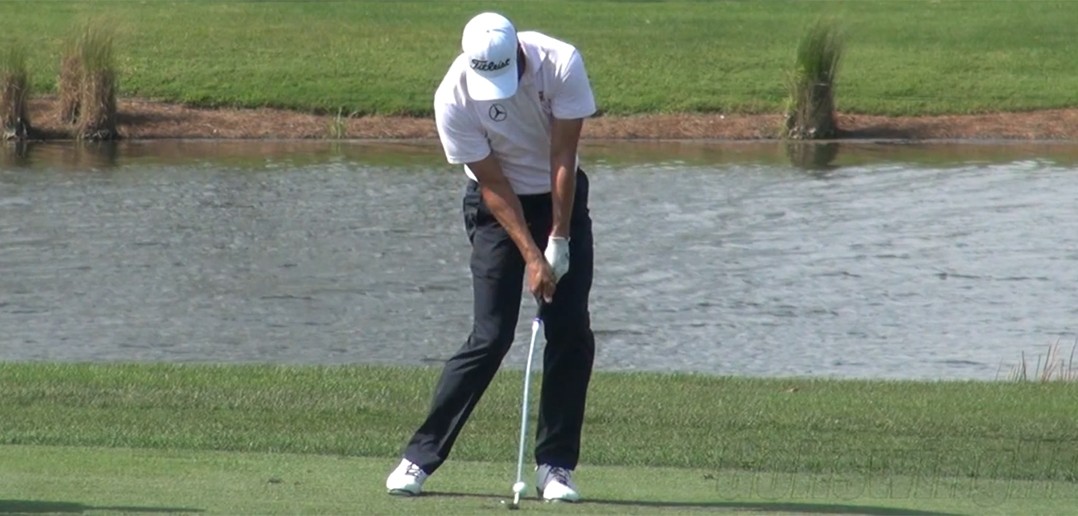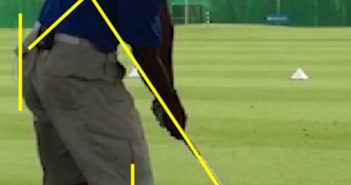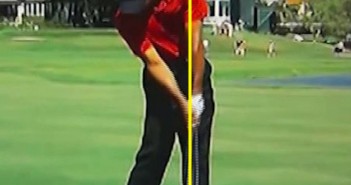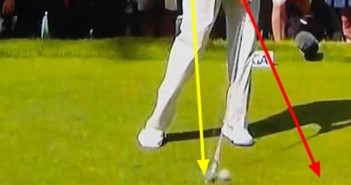This article and its accompanying drills will help you to achieve tour-calibre ball striking! They will teach you how to get into the perfect impact position every time. You will quickly learn how to move with the correct sequence and timing, and from the correct origin of movement. You will optimise your impact dynamics for more consistent, accurate, and powerful golf shots. And all this while making sure that you swing safely and without risk of injury.
You will also learn how to self-diagnose your golf swing; how to detect mistakes in your impact position, how to determine the root cause of those problems, and how to fix them.
We will also be publishing some detailed supporting articles that describe the mechanics of the golf swing, and specifically impact mechanics, which will explain how and why the impact dynamics described here actually work.
Introduction
Much has been written about the golf impact position over the years, and with good reason, it really is golf’s “moment of truth”.
Most instruction will tell you that how you strike the golf ball; the dynamics of the club head as it makes contact with the ball, and the launch conditions that send the ball towards the target, is, ultimately, all that matters.
The ball doesn’t know what your backswing looked like – you could have a swing that looks like, in the words of David Feherty, “an octopus falling out of a tree”, and still strike the ball beautifully with fantastic results. The game of golf is, after all, about getting the ball in the hole in as few strokes as possible.
Jim Furyk, who David was describing in his marvellous way, is one of the most consistent and effective ball strikers on Tour. Yet we don’t teach you to swing like Jim – no sane teacher would – and the reasons are simple. Jim Furyk has contrived a series of perfectly timed movements and compensations into his unique golf swing that, after many years of dedicated practice, enable him to get the club face consistently square through impact. To teach you to swing like Jim, we’d have to teach you all of those complex compensations – a near impossible task for us, and totally unlearnable for you.
If we tried, then you wouldn’t improve anywhere near as fast, the resulting golf swing wouldn’t be as effective as it might have been, and you’d have to put in a huge amount of practice to learn and then to maintain your overly-complex golf swing.
If you’re reading this, it’s probably because you want to improve your golf swing and play better golf. We need to strip away unnecessary movements and compensations and teach you what the most efficient and effective swing dynamics are, and most importantly how you can learn them.
So, impact is obviously crucial, but it’s not “all that matters”. How you can learn to consistently create the most effective impact conditions is key, and to do that you need to understand how to get there, and where “there” is.
The Importance of the Perfect Impact Position
We begin this downswing section by discussing the perfect impact position because it will help you to form a roadmap for understanding and learning a how to perform great golf swing.
Impact might be considered our “destination” as we learn the downswing.
It’s crucial, however, to understand that impact isn’t really a destination at all, it’s a position that we move through. The moment of impact lasts less than a millisecond. Proper impact dynamics can’t be contrived or forced, the downswing happens too fast, and to consistently create the right conditions in that moment of impact you need to orchestrate a precisely timed sequence of movements that begins as soon as you address the golf ball.
Every part of the golf swing feeds into the next, and any attempt to force, manipulate, or rescue the strike of the ball is counterproductive, and impossible to do consistently.
For example, a lot of golfers try to compensate for poor mechanics earlier in their swing by using their wrists aggressively to manipulate the club face through impact, perhaps trying to “slam the club face shut” in order to square everything up in time. If their timing is just slightly off, by only a tiny fraction of a second, then hooks and blocks abound!
To be consistent, impact needs to be the result of a natural, fluid and seemingly effortless golf swing. Great ball striking isn’t forced, the club face isn’t consciously manipulated (unless we’re trying to play a speciality shot and work the ball). Great ball striking happens naturally as a result of great swing mechanics.
As you make your swing, you shouldn’t really think in terms of impact at all. You don’t “hit at” the ball, you “swing through” it. Impact is just the ball getting in the way of the club face, and as far as the dynamics of your swing are concerned, the ball may as well not even be there – it can be very instructive to imagine that the golf ball is just a soap bubble that the club face passes through on its graceful arc.
Building the perfect golf swing is all about learning how to move efficiently, consistently and safely in order to create the optimal conditions as the club face passes through impact.
We use the impact position as a guide, a point on our roadmap, to help you to build the perfect golf swing.
You will achieve the perfect impact position by moving correctly throughout the golf swing – with the correct sequence and timing, and from the correct origin of movement – and this will mean that you will strike the ball with the correct impact conditions for optimal consistency, control, accuracy, and power.
Impact and Address the Same?
Some golf instruction suggests that your impact position should mirror your address position.
This is utter nonsense.
We only ever see this in high handicappers who use only their upper body, predominantly their arms and hands, to swing the golf club.
This requires a great deal of manipulation and hand-eye coordination in order to get the golf club back to impact with any success.
This is weak, inefficient and inconsistent, since you are relying on smaller muscles that are further from your centre, rather than rotating your hips and using the big muscles in the core of your body to generate club head speed.
Summary of the Perfect Impact Position
The perfect impact position is summarised below. Once again, apologies to the lefties out there, but for simplicity these instructions are given for a right-handed golfer.
In subsequent articles, we will present a series of drills which will quickly teach you how to move in order to achieve this position every time. You will also learn how to analyse your impact position to help determine how effectively your are moving through the entire golf swing, and to quickly identify the root cause and correct your own swing faults… 
or Log In
…enabling the arms to release powerfully through impact.
If you have any questions or comments about this or other articles on Golf Loopy, please send us an email.
The accompanying drills will help you to achieve tour-calibre ball striking! They will teach you how to get into the perfect impact position every time. You will quickly learn how to move with the correct sequence and timing, and from the correct origin of movement. You will optimise your impact dynamics for more consistent, accurate, and powerful golf shots. And all this while making sure that you swing safely and without risk of injury.
You will also learn how to self-diagnose your golf swing; how to detect mistakes in your impact position, how to determine the root cause of those problems, and how to fix them.
We will also be publishing some detailed supporting articles that describe the mechanics of the golf swing, and specifically impact mechanics, which will explain how and why the impact dynamics described here actually work.
Next up: Golf Swing Drill 502a – Downswing: Check Your Impact Position – Face On.




